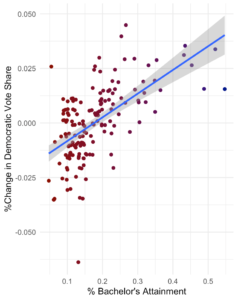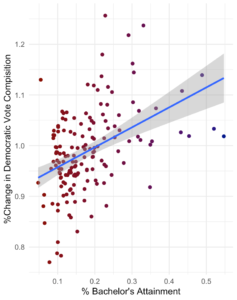For the second consecutive election cycle, Democrat Raphael Warnock will compete in a runoff for a Georgia Senate seat. Warnock won a plurality of the vote over the Republican nominee, Herschel Walker, but fell short of the 50% threshold needed to win the seat without a runoff. This time, the runoff will not decide the control of the Senate but is still essential for Democrats if the party wants any chance of retaining the Senate in 2024. While Republican Senate candidates in Pennsylvania and Arizona suffered decisive losses, Walker managed to run closer to expectations and only lost by a narrow 49.4% to 48.5% margin. Walker still ran significantly behind fellow Republican and Governor Brian Kemp, who routed Stacey Abrams by a comfortable ~8% margin. Georgia is a rapidly changing state, with different groups of voters shifting their political preferences every election cycle. What went down in Georgia on Election Day, and what are the keys for each party to come out of the December 6th runoff victorious?
What Went Down on November 8th?
Black Turnout Dropped
2020 Democratic success in Georgia was predominantly attributed to strong Black voter turnout around the state, both in the Atlanta area and in more rural areas. Black voters have historically driven Democratic success in Georgia, which is especially important given that Georgia is the third-most black state in the US. Although Black early voting numbers in 2022 looked strong, worrying Republicans, Black turnout lagged around the state compared to 2020. Although only county-level data is widely available (the gradual release of precinct-level data will allow analysts to make more informed claims), Democrats will be unhappy with preliminary analysis. According to regression analysis, the most Black counties (~60%) in Georgia are projected to compose a 3% smaller share of statewide turnout than expected compared to the least Black counties (~10%). Black turnout significantly lagged outside of the Atlanta metro area, including in pivotal Richmond County (Augusta, which only turned out at 93% of the expected level) and Muskogee County (Columbus, which only turned out at 94% of the expected level). Considering how strong Democrats run with Black voters in Georgia (Warnock is expected to have won ~90% of Black voters according to exit polling), these turnout problems could have potentially cost Warnock a chance to win without a runoff. Democrats (including Georgia Gubernatorial nominee Stacey Abrams) will likely blame decreased Black turnout in Georgia on “voter suppression,” referring to a set of restrictive election laws Georgia Republicans passed. Republicans will point to decreased black turnout across the US, arguing that their new election laws did not disproportionately affect Black voters in Georgia.
Fast Fact: Black turnout moderately decreased relative to 2020, dooming Warnock’s chance at an outright victory.

Educational Polarization Intensified
Democratic triumphs in Georgia in 2020 were fueled by exceptional Black turnout and persuasion of educated voters in both diverse and white suburbs and exurbs in the Atlanta Metro areas. Although Black turnout crashed in 2022, Warnock continued to enjoy gains for Democrats in educated areas. While Walker slightly outperformed 2020 Republicans in low-education counties, Warnock gained between 1-4% of the two-party vote in all eight high-education counties (>35% bachelor’s degree attainment). While some National Republicans hoped that educated suburbanites would shift back to the Republican Party with former President Donald Trump off the ballot, the national Democrats will be thrilled with continuing gains in educated areas.
Fast Fact: Continued persuasion of educated “swing” voters between 2020 and 2022 boosted the Warnock campaign and allowed him to win a plurality of the first-round vote.

The Democratic Electorate in Georgia is Changing
Given that Black turnout dropped so significantly compared to 2020, Warnock had an uphill battle based on the midterm electorate. Through increased success with educated voters in suburban and exurban Atlanta, Warnock not only was able to limp into a runoff but even won a plurality of votes in the first round. Even compared to 2020—an exceptionally successful year for Democrats with educated Georgians—Warnock experienced unprecedented success with educated voters, as highlighted above. These two trends combined to seriously change the Democratic composition of Warnock’s supporters, making the Democratic base in Georgia much less Black and much more educated than in the 2020 Senate elections. Voters in most Black counties composed about 5% less of the Democratic base than two years ago, while voters in the most educated counties composed about 10% more of the Democratic base compared to 2020. Although this change is fueled by differences in voter turnout across the country in Presidential vs. Midterm elections, it is also caused by shifts in voter preferences (racial depolarization and educational polarization) exemplified here in Georgia. The changing Democratic electorate will benefit Warnock in the runoff election since educated voters tend to be over-represented in lower-turnout elections.
Fast Fact: As the Democratic electorate in Georgia becomes less Black and more educated, runoffs will become far less structurally biased toward the GOP.


Turnout in Gwinnett County Tanked
Democrats will be extremely disappointed with the turnout in the diverse and suburban Gwinnett County. Although voters in Gwinnett boast educational attainment well above the national average, the county still only turned out at 91% of the expected rate in 2022, the worst among Georgia counties with at least 3,000 voters. As Gwinnett has the highest proportion of Asian and Hispanic voters in the state, Democrats will be left wondering whether their minority turnout programs were even less effective with these voters than Black voters.
Keys for the December 6th Runoff
Democrats: No Further Hemorrhaging of Black Turnout
Historically, Georgia runoffs tended to favor Republicans as the Democrat’s Black base turned out at lower rates than the Republican’s suburban and exurban base. But now, as suburbs and exurbs begin to trend toward the Democratic Party, the runoff math is a bit more unclear. Although Warnock was able to win just enough swing voters in the first round to survive the drop in Black turnout, a further decrease in Black turnout in the runoff election could be too much for Democrats to pull through. Black voters in Georgia are still an exceptionally reliable Democratic voter block, and the Warnock campaign needs to figure out a way to turn them out.
Republicans: Relative Turnout Boost in Exurban Atlanta
Although educated voters are trending towards Democrats, Walker still managed to put up impressive margins in educated and exurban areas of the Atlanta metro area. Since educated voters are more likely to turn out in runoff elections, Walker will hope that turnout success in areas like Forsyth and Cherokee County can offset increased Democratic turnout in places like Cobb and Fulton County.